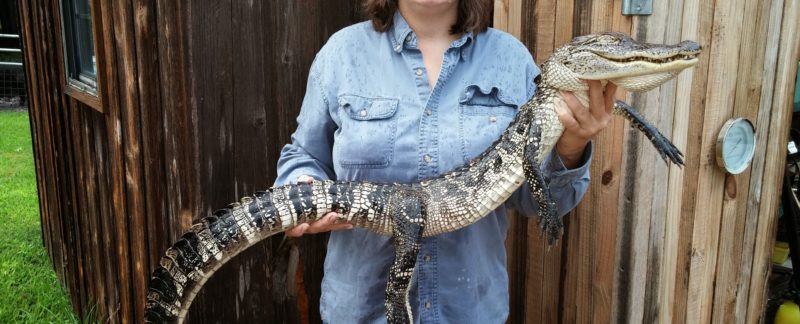Steve and I were lucky enough to get drawn for the night time management hunt at J. D. Mruphree WMA. It was an experience! Let me share it with you.
Unlike other draw hunts we were asked to be at the management area at 6 pm. Not 11 or 12 am like usual. The hunt was to take place from 7 pm on the first day and continue overnight until 7 am the next morning. You were asked to be out of the WMA by 7 am. That means everything loaded up and ready to drive off by 7 am.
We learned that these hunts are meant to control an overabundance of small alligators in the area. So many little munchers really take a bite (pun) out of the local animal population. The smaller gators prey relentlessly on frogs, crabs, baby birds, snakes, immature fish, turtles and anything else they can get in their little toothy mouths. Because they are the apex predator, a spike in the number of small alligators can make a tremendous impact on the food chain from top to bottom. Hence, the management hunt.
For this hunt the only allowable means of take was archery, but NOT crossbow, snare or gig. No baited lines were to be set because you could not control the size of the alligator caught. Only hands on, see and take, devices could be used. This was important because only alligators under 5 feet were allowed. A 5 foot 1/2 inch alligator would result in seriously unhappy managers and maybe even a hefty fine. There is no leeway here. The tags for management alligators are different than other tags and clearly identify the gator as a management animal.
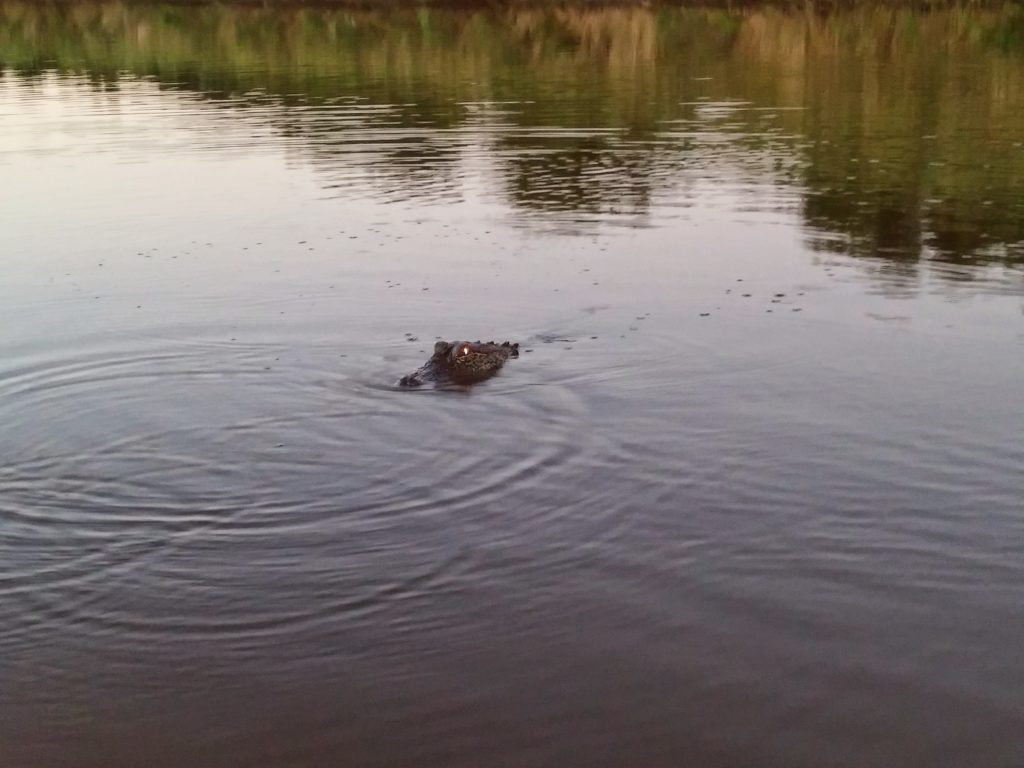
These photos were taken by my husband Steve at the Murphree WMA just last week. This alligator is around the 5 foot mark.

At the orientation we were given several examples of the proper size of alligator to take. Skulls were on hand to explain and show how to judge the size of a smaller gator. Still we were a bit apprehensive at our ability to determine correct size in a real life, heart thumping, adrenaline pumping, hunting situation. A moment that was quickly approaching.
A boat is a must for this hunt.There is just no way to do the kind of hunting required from the bank. If you don’t have a boat, or access to a boat, don’t bother entering this draw. The hunt coordinators looked over everyone’s rigs before assigning compartments to determine the best areas for each boat type. Ideally, you need a shallow draft flat bottom boat with a mud motor. We did not have a mud motor but did have a flat bottom. The vegetation in the compartments is thick and that is where most of the target gators like to hang out. Literally, they snuggle into the weeds and hang out waiting for something tasty to come by. So we had to keep constantly lifting the motor and cleaning out the weeds that were matted around the lower unit. We also had to keep a close eye on the water coming from the engine to make sure the water pump was still pumping and not clogged.
Of the three types of means of take, we elected to use a gig and a snare. With archery you have to be certain of the size of your gator because once shot, correct size or not, that gator is yours. Because of this many gators were passed on because they were too close to call for the inexperienced. Also, the smaller gators made for tiny targets and many were shot at and missed by a hair.
A gig is defined as such:
alligator gig –A lawful gig is a pole or staff equipped with at least one of the following: immovable prongs; two or more spring loaded grasping arms; or a detachable head.
For our gig we went with a 10 foot pole with a detachable head. The head slips off the driving pin on impact and stays in the alligator. It is connected to a line with a float (not shown) but for these smaller gators we just tied it to the boat. I do not recommend tying it to the boat for anything over five foot. Also, in heavy vegetation a float can slip through after the alligator but tying it to the boat might allow enough tangling and tension to possibly pull out of a big boy. Not to mention the ride you might take.


When using this type of gig it is important to hit the alligator as hard as you can driving the detachable head through the hide. Don’t worry about pulling the head off the pole, the alligator will do that for you.
Quickly.
With lots of splashing.
No matter how hard you hit however it is unlikely to penetrate the tough back-scales or head. Aim for the softer parts like the side, tail or the back of the head. Even an arm or leg will do.
Snare
I made our snares myself from 3/16 inch cable. In hindsight I should have used much smaller cable. The smaller alligators were sometimes able to wiggle enough to “swim” through the thicker cable loop. And do they wiggle!

After orientation we were assigned our compartments and shown our boundaries on a map with tips as to where to find our quarry. The guys were very helpful and as eager as us for our hunts to be successful. After that we all headed to the boat ramp to launch. Once we were all in the water we paraded out, hunt coordinators in the lead, to show us each how to get to our areas. Most of the compartments were located off of a large bayou which we would all use to come and go. One of the boats, a jet boat, was too large to get into the compartments so they were assigned that group the main bayou as their area.
As we approached the entrance to our area we could not help but notice the three sets of eyes glowing brightly just off the bank. I asked the guides if the eyes were in our area and OK to try and get. They were located in a smaller canal that paralleled the main channel. It was shallow and choked with weeds but some of it was open and passable for small boats. Most of the bayou has this secondary channel paralleling it. We were told that if we wanted to try we were welcome to them. So we eased up and readied the gig.
Once we got close enough to really see them it was clear that the gig was going to be a bit big for the job. None of the gators looked to be over three feet long. So the gig was set aside and the snare readied. If nothing else we looked on it as a chance to learn before heading into the main compartment and doing some “real” hunting. You know, for the dozens of four foot plus gators who were inside the compartment just waiting to fall to our hunting prowess. After some trial and error with two of the gators slipping out of the snare before we could tighten it Steve managed to successfully snare one. We were in business!
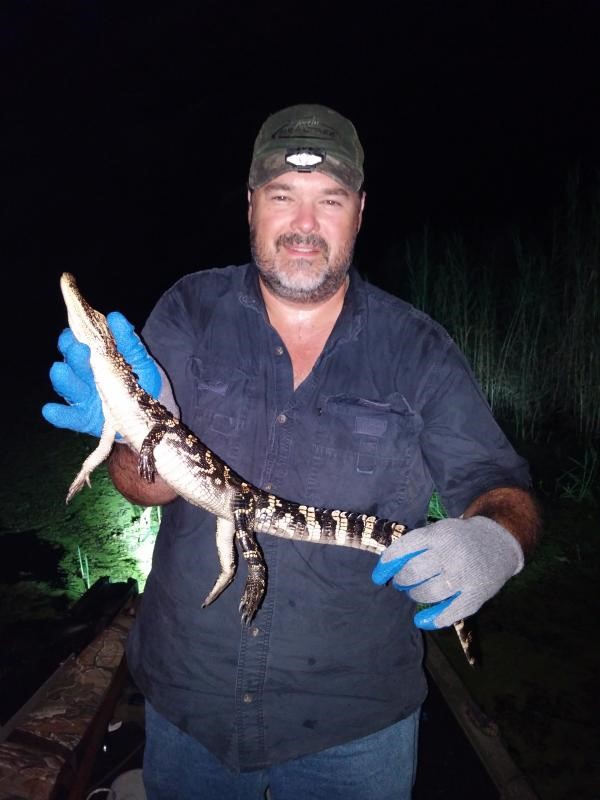
Once caught however we did not think it was near big enough and was not what the hunt managers had in mind. We knew they wanted small alligators taken but not this small. So our first catch was returned unharmed to the bayou. The other two alligators in the area were a bit bigger but became wary of our presence and would not allow us to get closer.

So with newly learned snaring skills we rolled the boat over the bank and entered the canal edging our compartment. They had told us that that was the most likely spot to find the smaller alligators they wanted removed from the area. Once in the canal that accessed the main lake in the compartment we began searching in earnest for those brightly glowing red eyes. You can see alligator eyes from a long way away. Even the small ones. Unfortunately we didn’t see any. There were none in the canal, none in the main lake or the various cuts and sloughs leading off it. We spent hours searching everywhere for anything that could remotely be an alligator. Finally we spotted a glowing set of eyes in the distant reeds and headed off to catch our first alligator. Once we got closer though it was clear that this was not a large gator. At all. The alligator turned out to be about 12 inches long. I swear it still had a bit of shell stuck to it’s nose it was that small. Not what we were hoping for so we passed. A little while later we finally caught a glimpse of a brighter set of eyes and went for a close look. This gator was a bit bigger, just, but it was down a weed choked slough and there was no way to get close without killing our motor or ourselves.
By this point we were quite discouraged and short tempered. Our engine did not like the thick weeds and we had to constantly clean off the mats that wrapped around the unit. The trolling motor battery was nearly dead from trying to navigate the shallow areas. Our arms and shoulders were hurting from all the paddling we had to do and our backs screamed from polling. In short we were NOT having a good time. It looked like we were going to go home empty handed and we were beginning to regret putting back that first little gator. At least then we would have something, no matter how pathetically small it was, to show for our efforts.
At this point it was only about 10 pm but we had nearly given up and were resigned to go home in defeat. There just were not any alligators in our area to be seen. We headed back to the rollers dejected and just prayed that those little alligators we had played with at the beginning were still there. Maybe we could catch one of them and salvage a little bit of hunting dignity.
As we pulled the boat over the levee we saw that two of the little alligators were indeed still there. Unfortunately, the group in the jet boat had also seen them and were swiftly closing in. They had the entire five or six miles of main bayou to hunt but chose the one little area we had available to us. We watched helpless as they made a successful shot on one of the only alligators we had even seen.
It was not their fault. Indeed it turns out that they were told that they could hunt both the main bayou and the smaller canals leading off of it. Including the canal in front of our compartment. We were happy that they got a gator. No so much that it was one of the last ones available to us. We talked with the group and learned that that was the first gator they had taken. They shot it with a bow so we had to admire the skill it took to hit one so small.
Now we were really dejected. We called the hunt manager and asked if there was another area that we could hunt. They said that the only open spot was the main bayou. The same bayou that the other group were hunting. With it as our only remaining option we met up with the jet boat to talk with them. They were very nice and more than willing to share the bayou. It was a lot of water after all. At first we played leap frog with them working down the waterway but quickly saw that it was not effective. So we told them that we would start at the far other end and work back up toward them. That way we weren’t in each others way.
We had to pass alligator after alligator in our trip to the far end of the hunt area. It was hard not to stop and try at some of them. We were feeling better though. At least we were finally seeing alligators. Things were looking up.
Once we got to the end and turned around we spotted our first target. It was bigger than the ones back at the slough but still well within the necessary size range. Since it was on the larger end I decided to try to gig (harpoon really) it. We eased up and had to wait several hours, or maybe a few moments, for the gator to turn. It was facing us and so my only shot was either the head or the back. Neither was an option for the gig. Also the little monster was about 15 feet from the boat. I would have to make a throw. Finally, several days later, it turned. I aimed for its neck but lower underneath the water that way it would be either a hit or a clean miss. I threw with all I had. As the gig left my hand the gator “jumped the string” and ducked under. The pole slammed into the empty water where I had aimed. Then the most wonderful thing happened. The rope began playing out. Somehow I had scored a hit! I just gigged an alligator! A friggin alligator! Let me say that again. I just gigged alligator!
I retrieved the pole and started pulling on the rope. The gator started pulling back. I had no idea where the dart had penetrated so I worked the line slowly. When the alligators head finally popped up I saw that I had somehow hit it in the head. They don’t like that very much. We worked it to the boat and finally saw that it was much larger then we thought. All of those warnings about not taking an alligator over five feet suddenly came to mind. I’ll admit that I was panicking a little. We wrapped the mouth and brought it on board and broke out the tape measurer. Tip to tail came out to 4 feet 5 inches. Whew! We put it back into the water and dispatched it with the 410 before tagging it. I can not explain how excited I was. I threw the gig, connected and fought an alligator. What a night!
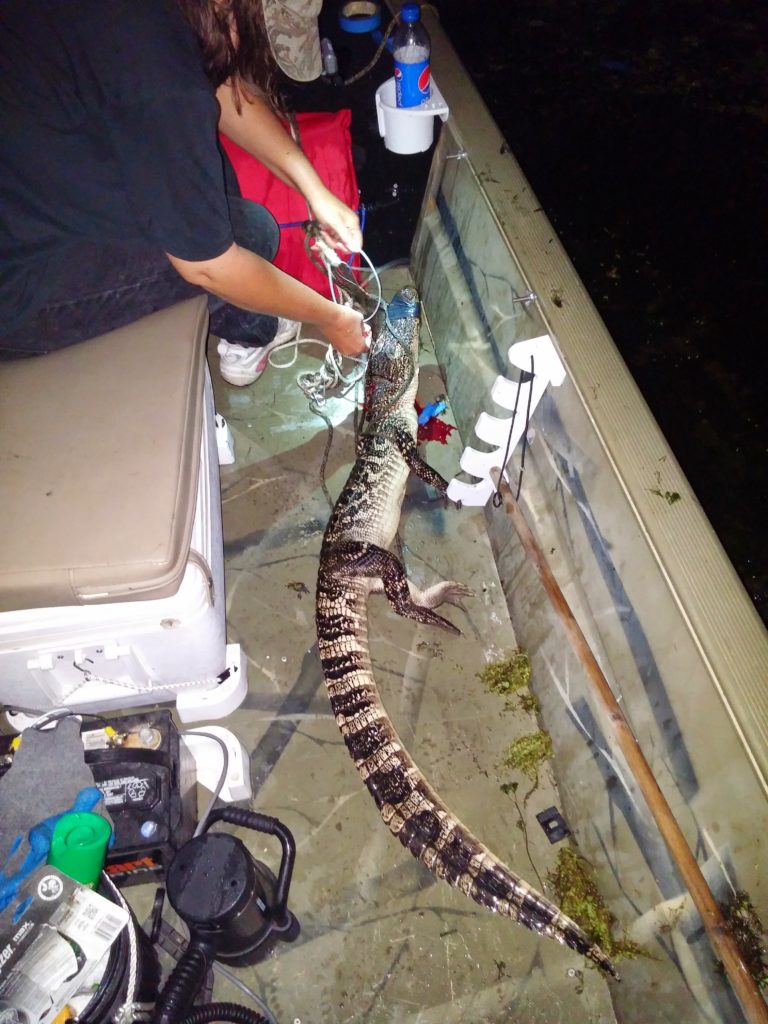
Once that excitement was over it was Steve’s turn. We quickly found another prospect and eased within gigging distance. This gator was broadside and Steve hit it with the gig hard driving it deep into the water. Unfortunately it seems that he had hit the tough scales at the top of the back. There was no penetration and the gator got away.
Next we came up on a smaller gator. Steve opted for the snare and easily worked it over the gators head. In seconds the snare was tightened and Steve boated a nice three footer. Since we were not seeing many of the bigger gators, except for some well over the 5 foot mark, I made a call back to the check station to make sure they were OK with the much smaller ones being taken. They said it was up to us. That our tags were for any alligator under 5 feet. So we lowered our expectations.
Over the next few hours we snared four more gators including one that turned out to be 5 feet 4 inches. That one was released. So in the end we filled all of our tags but one. Steve took three alligators. One measured 3 1/2 feet one 2 1/2 and one 2 foot 3 inches. Aside from my 4 1/2 footer I snared a 3 1/2 footer. So we returned to the check station with five alligators and huge smiles.

The night had started out dismal but, thanks to the hunt managers moving us to the main channel, we ended it with high spirits. The hunt managers were happy with our harvest as well. They said that the ones we killed were exactly what they were looking for. Of the 16 hunters only two others had taken one gator each. One was with archery, the one we watched being taken. We don’t know how the other was taken.
Here’s my “big boy”.
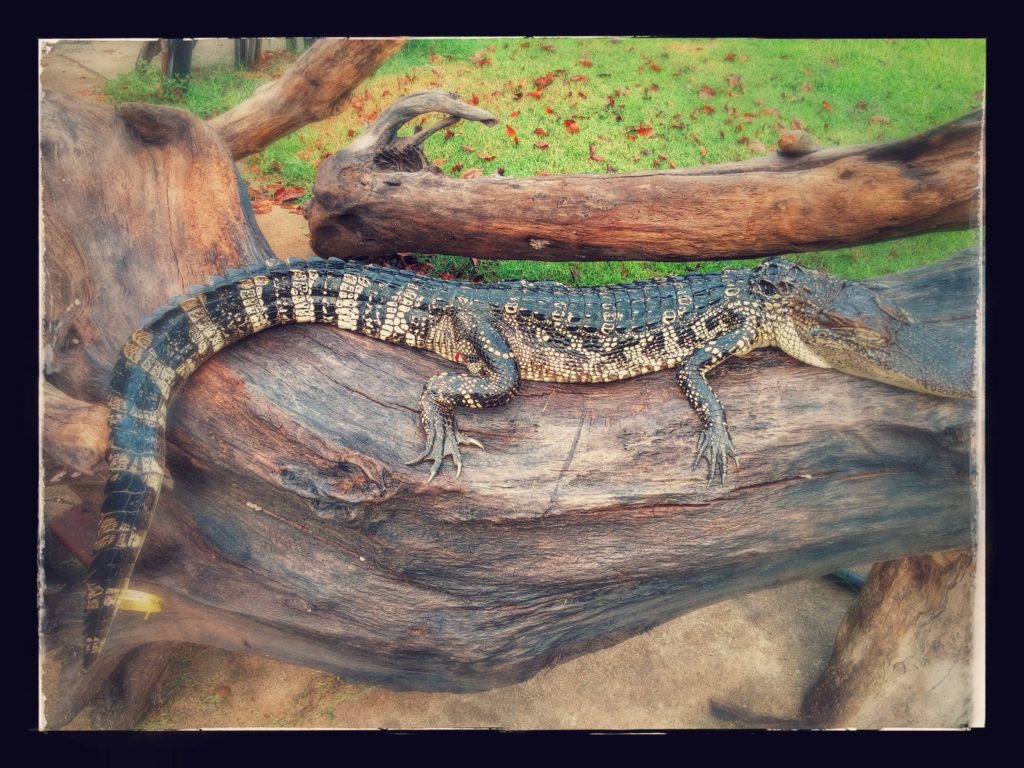
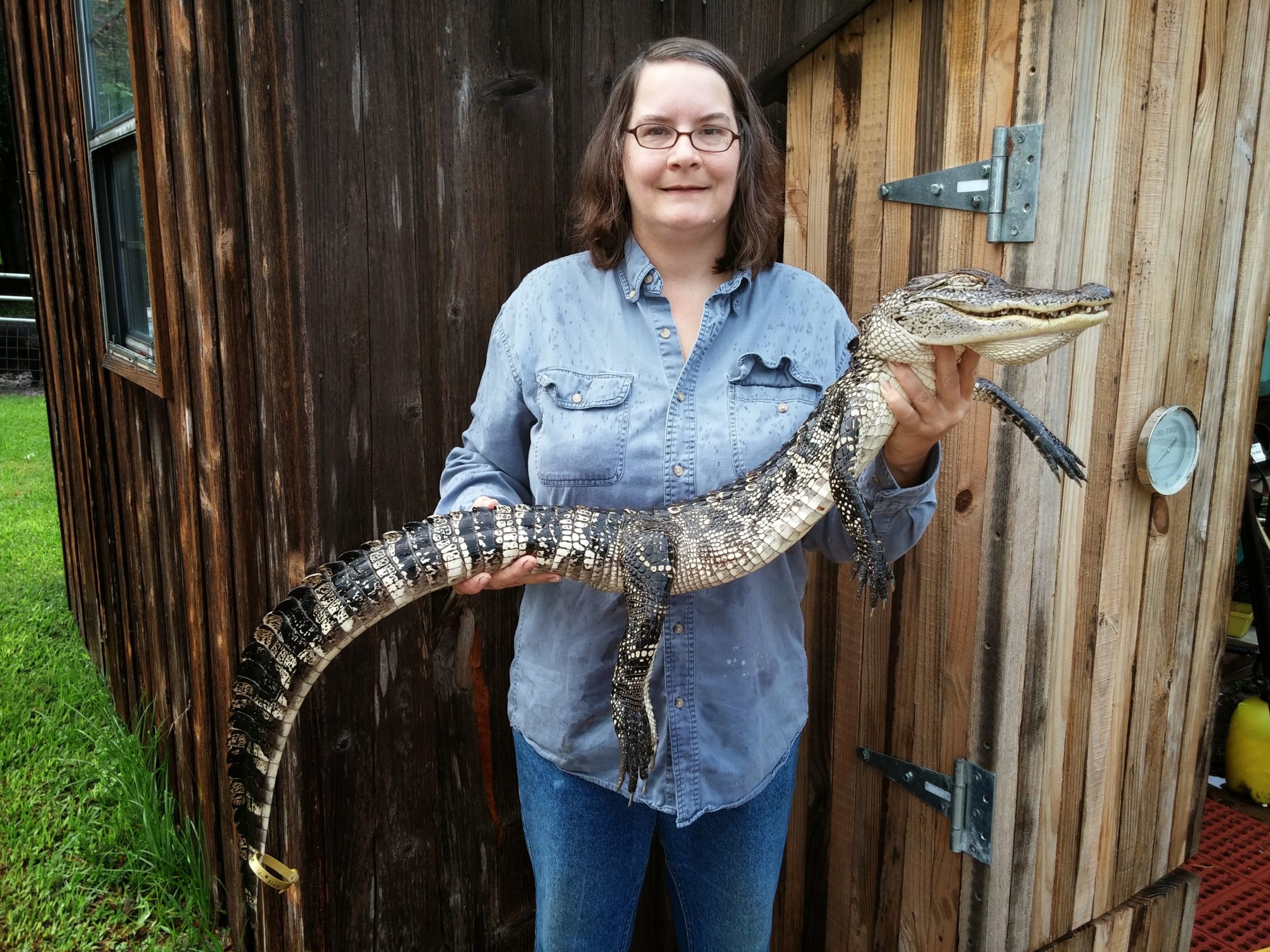
Some tips for future hunters.
Make sure your boat is in good working order.
Make sure your boat is in good working order. Yes, it’s that important.
Bring lots of bug spray.
An extra battery is a good idea. Two is better.
Some way to paddle or push through heavy vegetation is a must.
Wear dark clothing. They can see you!
Bow lights help to blind the gator and aid in getting close.
Snares seem to be the best option.
Don’t think you will bring home lots of meat. These gators have very little on them.
Did I mention bug spray?
Turn off all other lights not directly on the gator. Don’t have any lights behind you.
Stay quiet while on approach. They can hear you!
The motor didn’t seem to bother them.
Oh and bug spray.
Also. Don’t think that you will bring home a ton of meat from this hunt. These little gators, even the biggest, didn’t have much meat on them.
Here is the 3 footer skinned out. We were able to get 1 lb 5 oz of meat off this guy.

This fellow aged at 6 years old while the larger 4 1/2 footer was 9 years old.

We can’t say enough good things about the guys running the hunt at J. D. Murphree. They were friendly, helpful and eager to help in any way they could. It would have been a different hunt without them.
For more stories of our Texas Public Hunt Adventures go HERE.
![]()
